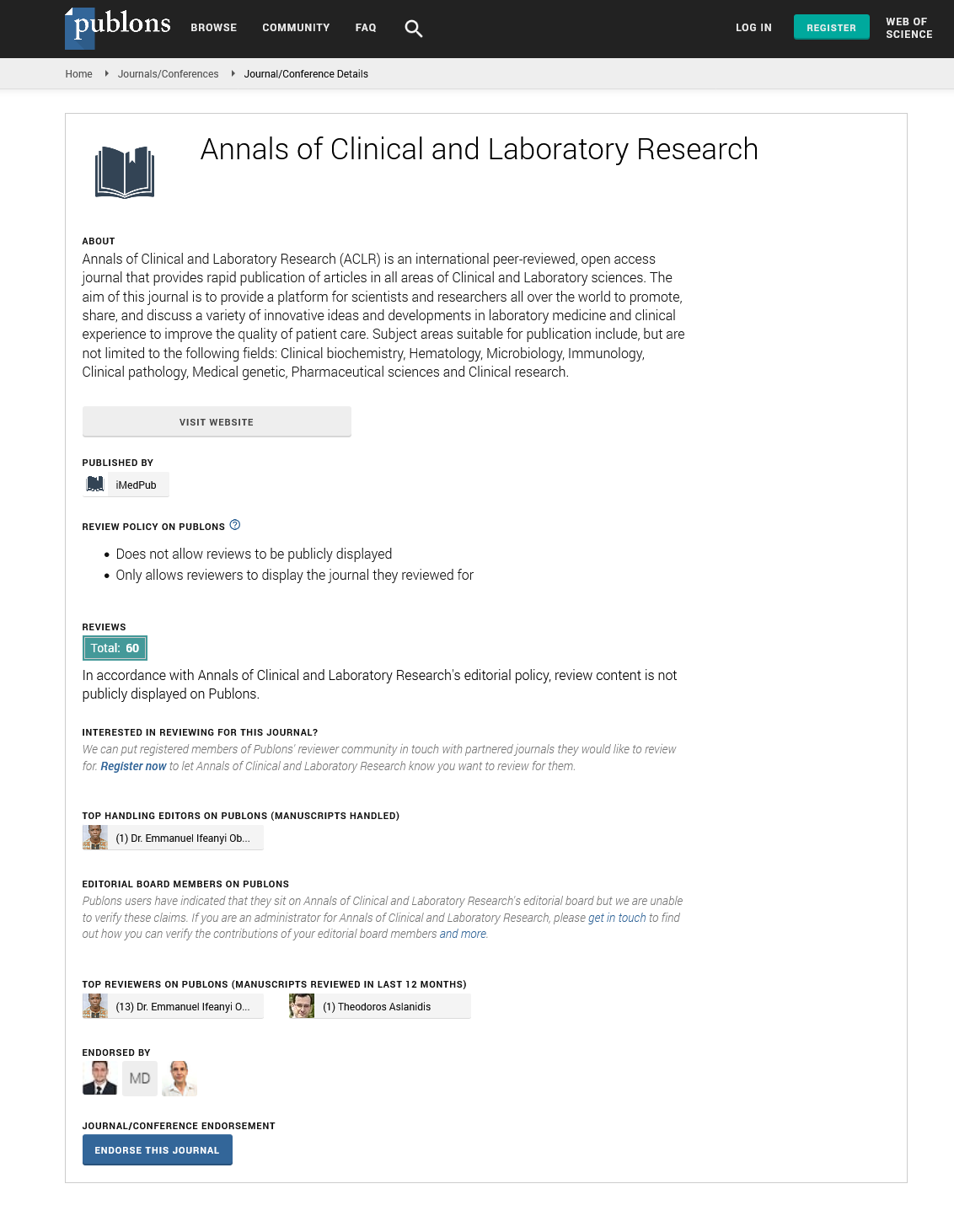Commentary Article - (2025) Volume 0, Issue 0
Commentary on “Real-World Application of Digital Morphology Analyzers: Practical Issues and Challenges in Clinical Laboratories’’
Hanah Kim1,
Mina Hur1,
Giuseppe d’Onofrio2 and
Gina Zini3*
1Department of Laboratory Medicine, Konkuk University School of Medicine, Seoul, Republic of Korea
2Department of Hematology, Università Cattolica del S. Cuore, Rome, Italy
3Department of Hematology, Università Cattolica del S. Cuore-Fondazione Policlinico Gemelli, Rome, Italy
*Correspondence:
Gina Zini,
Department of Hematology, Università Cattolica del S. Cuore-Fondazione Policlinico Gemelli, Rome,
Italy,
Email:
Received: 20-Mar-2025, Manuscript No. IPACLR-25-15634 ;
Editor assigned: 24-Mar-2025, Pre QC No. IPACLR-25-15634 (PQ);
Reviewed: 07-Apr-2025, QC No. IPACLR-25-15634;
Revised: 14-Apr-2025, Manuscript No. IPACLR-25-15634 (R);
Published:
23-Apr-2025
Abstract
The rising epidemic of Metabolic Dysfunction-Associated Steatotic Liver Disease (MASLD) and Metabolic Dysfunction-Associated Steatohepatitis (MASH) presents a significant healthcare challenge due to their high global prevalence and the often-delayed diagnosis of advanced stages. Liver biopsy, although considered the gold standard for diagnosing MASLD/MASH, remains invasive, costly, and prone to inter-observer variability. In recent years, Velacur™, a quantitative ultrasound-based technology, has gained attention as a promising alternative for non-invasive assessment. This commentary aims to review the key findings of Sheikh et al.'s study on Velacur’s accuracy in diagnosing MASLD and MASH. It explores recent updates and innovations in its development, as well as ongoing challenges and potential clinical applications. By reviewing these developments, we aim to highlight the potential of Velacur™ in improving liver disease diagnostics in both research and clinical settings.
Description
Digital Morphology Analyzers (DMAs) have revolutionized hematology by automating the microscopic evaluation of blood and body fluids. These systems enhance efficiency, improve standardization and reduce observer-dependent variability in manual slide reviews. While DMAs promise significant advantages in clinical laboratories, their real-world application presents several practical issues and challenges. This commentary explores the benefits, limitations and potential solutions for implementing DMAs effectively in routine laboratory workflows.
DMAs are designed to automate the identification and classification of blood cells using Artificial Intelligence (AI) and machine learning algorithms.
They offer several advantages:
Enhanced Standardization and Accuracy: Traditional manual morphology is highly subjective, dependent on the expertise of the individual performing the review. DMAs minimize variability by applying consistent image analysis algorithms, reducing human error and improving diagnostic accuracy.
Improved Workflow Efficiency: DMAs systems allow laboratories to process and analyze large volumes of slides quickly. This reduces turnaround time for reporting results and enables laboratory personnel to focus on more complex cases.
Remote and Collaborative Analysis: Many DMAs are integrated with digital pathology platforms, allowing real-time sharing of images for second opinions, education and consultation between specialists across different locations.
Data Storage and AI Integration: Digital images can be stored for future reference, re-evaluation and training purposes. AI-driven advancements allow continuous improvements in classification accuracy and decision support.
Despite these advantages, real-world adoption of
DMAs comes with several technical and operational
challenges
Cost and Infrastructure Requirements: One of the primary barriers to DMAs adoption is the high initial investment. These systems require advanced imaging hardware, AI-driven software and data storage capabilities. Additionally, laboratories need to invest in training staff to effectively operate and interpret results from these systems. Smaller or resource-limited laboratories may find these financial and infrastructural demands prohibitive.
Algorithm Limitations and Validation: AI-based image analysis relies on pre-trained models to classify cells accurately. However, variability in sample quality, staining techniques and rare cell morphologies can challenge these algorithms. Many DMAs perform well in routine cases but may struggle with abnormal cells such as blasts, dysplastic cells, or parasitic infections. Continuous validation and recalibration are necessary to ensure accuracy across diverse patient populations.
Standardizing quality control measures across different DMA platforms remains a challenge. Laboratory accreditation agencies and regulatory bodies require rigorous validation before integrating new technologies into clinical workflows. Laboratories must ensure compliance with regulatory standards such as the Clinical Laboratory Improvement Amendments (CLIA) and guidelines from organizations like the International Council for Standardization in Hematology (ICSH) and the International Society for Laboratory Hematology (ISLH).
Transitioning from manual microscopy to DMAs requires laboratory staff to adapt to new workflows and develop digital competency. Some experienced technologists may initially resist these changes, fearing the loss of traditional expertise. Continuous training programs and hands-on workshops are crucial to ensuring smooth integration.
To maximize efficiency, DMAs must integrate seamlessly with Laboratory Information Systems (LIS) for real-time reporting and data management. However, compatibility issues between different DMA platforms and LIS can lead to workflow disruptions. Laboratory IT teams must work closely with vendors to customize interfaces and ensure smooth data exchange.
Several strategies can help overcome these
challenges and enhance the real-world application
of DMAs in clinical laboratories
Cost-Effective Implementation: Laboratories can adopt a phased approach, implementing DMAs for high-volume or specialized cases before full integration. Collaborative purchasing or leasing models can also reduce financial burdens.
Algorithm Improvement: Through continuous training of AI models with diverse datasets to improve accuracy in identifying rare and abnormal cell types.
Industry-wide standardization of staining, imaging and reporting protocols can enhance reproducibility and comparability across different laboratories.
Comprehensive Training Programs: To facilitate smoother adoption and increase confidence in DMAs results.
Enhanced Interoperability Solutions: Developing flexible software that integrates with multiple LIS platforms, ensuring seamless workflow integration.
Conclusion
In conclusion, DMAs hold immense potential to enhance hematology diagnostics by improving accuracy, efficiency, and remote collaboration. However, real-world implementation is hindered by cost, algorithm limitations, regulatory concerns, staff training needs, and interoperability issues. Addressing these challenges through AI advancements, regulatory standardization, and strategic implementation approaches will be key to maximizing the benefits of DMAs in clinical laboratories. With continued technological evolution and acceptance, DMAs can become a standard tool for improving hematological diagnostics worldwide.
Citation: Kim H, Hur M, d Onofrio, Zini G (2025) Commentary on “Real-World Application of Digital Morphology Analyzers: Practical Issues and Challenges in Clinical Laboratories’’. Ann Clin Lab Vol.13 No.S5: 001
Copyright: © 2025 Kim H, et al. This is an open-access article distributed under the terms of the Creative Commons Attribution License, which
permits unrestricted use, distribution and reproduction in any medium, provided the original author and source are credited.






